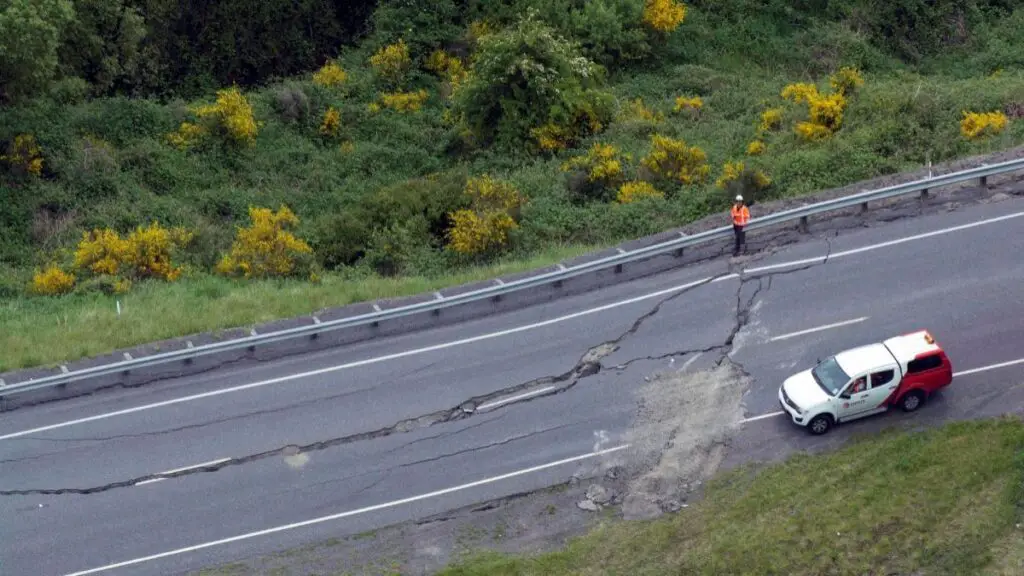New Zealand Rattled by 5.6 Magnitude Earthquake
New Zealand woke up to a jolting surprise on the morning of September 20 as a magnitude 5.6 earthquake shook the central South Island. Despite the intensity of the quake, there have been no immediate reports of major damage or injuries, bringing relief to the nation.
Location and Depth of the Earthquake
The earthquake epicenter was located approximately 124 kilometers (77 miles) west of Christchurch, according to the U.S. Geological Survey. With a relatively shallow depth of 11 kilometers (7 miles), the quake’s impact was more strongly felt. Shallower earthquakes tend to reverberate with greater force, further magnifying the jolt experienced by residents.
No Tsunami Risk and Minimal Damage Reported
New Zealand’s National Emergency Management Agency swiftly assured the public that the earthquake did not pose any tsunami risk. Reports indicate that the agency has not received any significant reports of damage in the aftermath of the quake. This news brings a sense of relief to both the authorities and the understandably concerned citizens.
Thousands Report Feeling the Earthquake
The GeoNet monitoring agency, responsible for earthquake detection in New Zealand, received an overwhelming response from more than 14,000 individuals who reported feeling the earthquake. Residents spoke of experiencing a strong, rocking motion, while the intensity of the quake triggered multiple alarms throughout the affected areas. The surge in reports highlights the quake’s impact on the local population.
New Zealand: The Shaky Isles
5 million people call New Zealand home, a nation often jokingly referred to as the Shaky Isles due to its frequency of earthquakes. The country is situated on the “Ring of Fire,” an arc of seismic faults encircling the Pacific Ocean. This geographic positioning makes New Zealand prone to earthquakes and volcanic activity, characteristics that contribute to its breathtaking natural beauty, but also pose challenges to its infrastructure and safety.
The recent 5.6 magnitude earthquake serves as a reminder of the precarious position New Zealand occupies in terms of seismic activity. However, the nation’s robust emergency management systems and preparedness initiatives play a vital role in mitigating the potential risks associated with such events.
Despite the absence of immediate major damage or casualties resulting from this particular earthquake, the incident underscores the importance for New Zealanders to remain vigilant and well-informed about earthquake safety protocols. Maintaining awareness and preparedness can significantly reduce the impact of future seismic events on individuals and communities.
Earthquake Preparedness and Public Safety
Enhancing earthquake preparedness and public safety is crucial for New Zealand, given its geographical vulnerability. Government bodies and emergency agencies play a critical role in educating the population about the risks associated with earthquakes and providing guidance on how to respond during and after such events.
Public awareness campaigns, strong building codes, and regular drills ensure that citizens are well-informed and equipped to handle seismic incidents. Initiatives like the ShakeOut earthquake drill, an annual nationwide exercise, aim to educate individuals and organizations about the appropriate actions to take when an earthquake occurs.
Furthermore, efficient monitoring systems like GeoNet enable the rapid collection and analysis of earthquake data, providing valuable insights to scientists and experts. This allows for continuous improvements in early warning systems, advancing the ability to issue timely alerts and notifications in the event of an earthquake.
The Importance of Preparedness
New Zealand’s resilience in the face of earthquakes cannot be understated. The nation has long recognized the necessity of earthquake preparedness due to its unique geographical position. By understanding the inherent risks and implementing proactive measures, New Zealanders are better equipped to respond and recover from seismic events.
Preparing for an earthquake involves not only the government and authorities, but also individual citizens, communities, and businesses. This collective effort ensures a more robust and resilient response when earthquakes do occur.
Key preparedness measures include:
- Creating Emergency Kits: Assembling essential supplies such as food, water, medications, and first aid items to sustain individuals and families in the immediate aftermath of an earthquake.
- Developing Emergency Plans: Establishing evacuation routes, identifying meeting points, and communicating emergency contact information to ensure the safety and well-being of loved ones.
- Securing Infrastructure: Implementing seismic retrofitting techniques in buildings and infrastructure to enhance their resilience and minimize potential damage.
By investing in preparedness initiatives and fostering a culture of resilience, New Zealand continues to lead the way in earthquake response and recovery.
A Nation United by Resilience
While the recent 5.6 magnitude earthquake may have momentarily unsettled New Zealand, it serves as a testament to the nation’s unwavering resilience. The ability to rebound and recover from seismic events exemplifies the strength and spirit of the New Zealand people.
As the Shaky Isles continue to face the inevitability of earthquakes, the nation remains dedicated to improving its emergency response capabilities and ensuring the safety and well-being of its citizens. By investing in research, education, and infrastructure, New Zealand sets an example for the world in proactive earthquake preparedness.
With the collective efforts of government bodies, emergency agencies, and individuals, New Zealand reaffirms its commitment to facing the challenges posed by its geographic location, all while cherishing the awe-inspiring beauty that has rightfully earned it the nickname “The Shaky Isles.”


